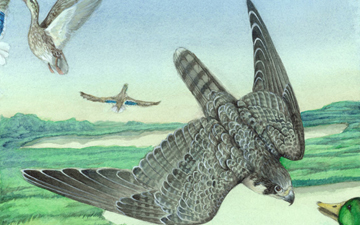The Peregrine Falcon (Falco peregrinus), also known as the Peregrine,[2] and historically as the “Duck Hawk” in North America,[3] is a cosmopolitan bird of prey in the family Falconidae. The Peregrine is renowned for its speed, reaching speeds of over 320 km/h (200 mph) during its characteristic hunting stoop,[4] making it the fastest extant member of the animal kingdom.[5][6]
It is a large, crow-sized falcon, with a blue-gray back, barred white underparts, and a black head and “moustache”. Experts recognize 17 to 19 subspecies which vary in appearance and range; there is disagreement over whether the distinctive Barbary Falcon is a subspecies or a distinct species. Typical of bird-eating raptors, all subspecies of F. peregrinus, including the nominate, are sexually dimorphic, with females being considerably larger than males.[7][8]
The Peregrine’s breeding range includes land regions from the Arctic tundra to the Tropics. It can be found nearly everywhere on Earth, except extreme polar regions, very high mountains, and most tropical rainforests; the only major ice-free landmass from which it is entirely absent is New Zealand. This fact makes it the world’s most widespread bird of prey.[9] Both the English and scientific names of this species mean “wandering falcon”, referring to the migratory habits of many northern populations.
While its diet consists almost exclusively of medium-sized birds, the Peregrine will occasionally hunt small mammals, small reptiles or even insects. Reaching sexual maturity at one year, it mates for life and nests in a scrape, normally on cliff edges or, in recent times, on tall human-made structures.[10] The Peregrine Falcon became an endangered species in many areas due to the use of pesticides, especially DDT. Since the ban on DDT from the beginning of the 1970s onwards, the populations recovered, supported by large scale protection of nesting places and releases to the wild.[11]
(From Wikipedia, March 1, 2011)
– – –
- Fastest animal recorded at speeds in excess of 200m.p.h. (more information)
- WWII japanese airplane Nakajima Ki-43 Hayabusa (Japanese for Peregrine Falcon) code name Oscar by Allies (more information)
- Names: also known as the “Duck Hawk”. A male Peregrine is called a “tiercel” and the female is “falcon”. The name “Peregrine” means wanderer.
- Falconry: Falconry (the art of hunting with a raptor) is known back to the time of the Egyptions. In the Middle Ages it was known as the “Sport of Kings.” Social rank dictated which species an individual was allowed to hunt with. A baron or duke could use a male Peregrine while you had to be a prince to have a female Peregrine. (more information)
(Info via EOL from Mary Hennen)
– – –




